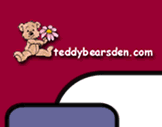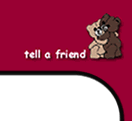|
CLOSING AND FINISHING YOUR BEAR
Tips & Hints | Bear Making Terms
...AND MORE ON STUFFING
- Use small wads of stuffing (no bigger than the size of a cotton ball). Start at the neck and use a stuffing tool to get the filler in and around the joints. Even a soft stuffed bear needs to be firmly stuffed at the neck to avoid a floppy head.
- Stuff around the shoulders and arms and then begin at the lower part of the body.
-
If you are thinking of a growler or music box, place it now
| (a) |
Make a cotton sack for the growler to protect it from bits of fiberfill getting inside the mechanism. |
| (b) |
If you want the bear to growl if tipped forwards, then place the growler in the middle of the body cavity in a horizontal position with the holes facing backwards toward the center back seam. |
| (c) |
Pack stuffing around the growler so it won't fall out and also around the top so it cannot be felt when the seam is closed. |
- Stuff the bear so that the final seam can be squeezed relatively easily with your fingers while you stitch.
The Ladder Stitch
Close both seams invisibly with a ladder stitch.
- Thread a needle with a strong thread and knot the end.
- Place the needle at the top of the seam to be closed and anchor the knot.
- As illustrated below take the thread horizontally across the opening and make a small stitch on the opposite side.
- Repeat on the other side and all the way down the length of the limb or the body seam.
- Pull the stitches to close the seam.

The Eyes & Ears are Related
|

|

|
|
large eyes, wide space
|
Medium eyes low; ears high
|
|

|

|
|
small eyes high up; ears low
|
large eyes wide space; ears high
|
|

|
|
vary eye placement here. Usually no higher than 1/2 way between nose and ear line
|
Ears
-
Ears and eye placement will determine the personality or character of your bear. Remember equal spacing proportions - after that there are no hard and fast rules regarding placement.
-
Pin ears in place first. Curve forwards to give the natural look. Keep moving the ears around until you are satisfied with "the look" then sew them in place.
-
Anchor the thread behind the ear. Use the ladder stitch working top to bottom on the back of the ear and then up the front.
-
Preserver the curve of the ear as you stitch.
Noses
Take your time with a bear nose. After all, it's one of your bear's most obvious features. Beginner and experienced bear makers alike know the frustration of embroidering that perfect nose.
Method 1 for noses
-
Make a felt, leather or ultra suede template (see illustration). Position in a central place on the muzzle.

-
Trim the surplus mohair from the nose area. When fur is removed right to the backing fabric glue the template in place (white glue is fine).
-
Stick pins in lightly and allow template to completely dry in place (overnight is best).
-
Thread a leather or darning needle with the perle cotton of choice. Cut cotton approximately 25" (70cm) long.
-
Lay 2 or 3 horizontal stitches across the top of the felt template. The secret to any bear nose is an even tension.

-
Completely embroider over the template by starting at one side and placing cotton in even stitches side by side to cover.
-
For the mouth, bring the needle out at point A and into the bear at point B and up out at C. Allow thread to pass under A to B length. Pull and adjust until preferred expression is created.

Method 2 for Noses
-
Clip away a small area where you plan to put the nose.
-
Stitch an outline of your nose and then fill in with satin stitch. Keep the tension as even as possible.
-
Cover the whole area with satin stitch several times until you have achieved the look you want.
Method 3 for Noses
Consider leather, plastic, flocked and now really quite stuffing blown glass noses.
Some ideas for embroidered noses:

|
For noses - if it's not the look you want - pull out and restitch. Keep cutting and restitching until you are happy with your bear.
|
Trimming the Face

above: trim between eyes and nose; muzzle trim.
Tips for Trimming - Remember it doesn't grow back!
-
Small sharp scissors are the best.
-
Work SLOWLY. Cut bit by bit to get the idea of how much you'd like to trim.
-
Leave 1/8 - 1/4" (3-6 mm) of fur covering if you are using a knit back pile.
-
Woven back fabrics can be trimmed as much as you like since the backing is solid.
-
Consider a five o'clock shadow or stubble effect.
Those Eyes
For most collectible teddy bears, glass eyes are used. If the bear is intended for a child, then use safety eyes. Trim around the eye placement areas since most bears would like to see where they are going!
-
Most eyes are hand made and there is a wide variation so match the eyes at the time of purchase. If you will be making many bears and are quite a distance from your supplier, then purchase a dozen pairs and match 'em up.
-
If you purchase your eyes "on a wire" - twist them while they are joined. Form a loop and then twist 3 or 4 times. Do other eye and then separate with wire cutters.

-
Positioning eyes takes time. One easy way to use eyes on a wire with no loop. Simply cut the wire to a convenient pin length. Lightly press the eyes into position and keep on repositioning until you achieve the look and expression you want.
-
Take the trial eyes out. Use an awl at the point of entry and make a hole wide enough to take the loop on the eye.
-
Cut a length of doubled dental floss or nylon upholstery thread that will be long enough to pass through the head and leave room to tie off.
-
Loop the thread through the loop on the eye and tie the eye at approximately the middle of the thread. Double knot to make more secure.
-
Thread one of the double ends onto an extra strong long needle (I use doll sculpting needles). Push the needle through the head until it comes out at the base of the head just above the neck disk on the opposite side. OR until it comes out at the middle point behind the opposite ear.
-
Take the needle off the thread and pass the other doubled tail of thread until it comes out at about 1/4" from where the other thread had been pulled through.
-
Pull the threads tightly and knot them securely. The pressure will pull the eye into the head and create a natural eye socket. Bury the thread inside the head.
-
Repeat for the other eye.
-
Glass eyes can and do break. Consider using safety lock eyes but remember these must be installed before you stuff the head!
-
If you want your eyes to be less shiny - scratch 'em up a little with sand paper or dull them with a bit of hand cream.
|






